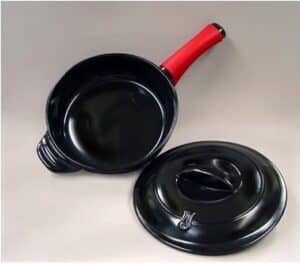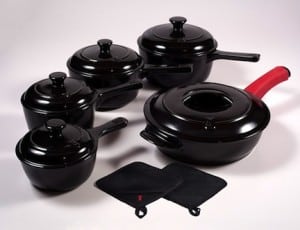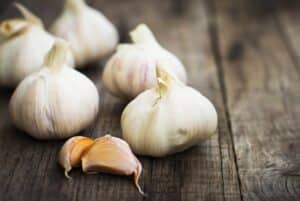
Since the 1980s I’ve cherished 100% ceramic cookware. To understand why, let’s consider roasted marshmallows. Some folks like to quickly toast/scorch the outside of their marshmallows, while others carefully slow-roast their soft little pillows until the heat deeply penetrates the core, enhancing the flavor throughout and—careful now—melting the sticky goodness right off the twig.
Because metal cookware quickly absorbs and emits heat (it has high thermal conductivity), a thin metal pot is ideal for bringing liquids to a rapid boil or for stir-frying when you want the outside to quickly cook or sear. In other words, slow heat transfer is not a desired feature in a teakettle, pasta pot, stockpot or wok.
Ceramics, on the other hand, have a lower thermal conductivity than metal. They slowly absorb and emit heat, and unlike metal pots, they radiate healthful far infrared energy. Ceramic cookery slowly, gently infuses the food throughout and enhances the food’s subtle flavors. To complete the marshmallow analogy, while a marshmallow would quickly scorch in a hot steel wok, in a ceramic pot you could slowly warm it into goo.
So while a pure ceramic pot is slower to heat up, once hot it evenly and gently conveys heat, making it valuable for every cooking application but flash cooking. I also favor 100% ceramic cookware because it is nonreactive and free of metals, so there’s no chance of it tainting the food with metallic or synthetic ions.
Note: So-called ceramic nonstick cookware is not a true ceramic but rather a chemically based polymer coating that typically covers an inexpensive metal pan or pot. As with all nonstick surfaces, it pits, wears and degrades with normal use and then leaches heavy metals into food. Because ceramic coated cookware becomes reactive with use, it is not recommended.
Let’s go back to the 1980s for a second: Brown rice had then been a key dietary staple for me for 15 years. I knew its flavor. Then I had my first taste of it made in a ceramic insert (the ceramic insert, called an Ohsawa pot, nestles inside a metal pot). What a revelation. Although the difference was subtle, the rice was detectibly sweeter and tenderer. I was a ceramic convert!

I next discovered a Japanese donabe pot, which can be used directly on the range top as well as in the oven, and this more versatile pot vastly expanded my ceramic cookery.
More recently there’s a whole line of moderately priced 100% ceramic cookware, produced by Ceramcor and available as both Xtrema* and Mercola. These black pots, pans and bakeware items are resistant to temperature change and can go directly from the freezer into a hot oven or stovetop and then the dishwasher. I’ve been enjoying Xtrema cookware for 8 years. Though I haven’t slow roasted a marshmallow in it, these pots are a pleasure to handle and use, and I appreciate the way they enhance the flavors of foods.
Note: Heretofore 100% ceramics were most often available as dish ware (like the illustrated soup tureen), vases or bakeware (like casseroles and ramekins) and valued for both their beauty and non-reactivity. Special firing is required to make them suited for stove top cooking. CorningWare had a line of inexpensive pyroceramic pots, their Visions line. This product was a poor heat conductor and is no longer produced.
Rebecca Wood is the author of The New Whole Foods Encyclopedia* and The Splendid Grain.* For over 30 years she has helped people regain their health and energy with an easy-to-implement whole foods diet. Visit her website to see find more articles, recipes, and tips. Find out about her books and diet consultations at www.rwood.com.
- Explore VegKitchen’s other Green Kitchen articles, as well as the wealth of kitchen tips
in the entire Healthy Vegan Kitchen area.
*This post contains affiliate links. If the product is purchased by linking through this review, VegKitchen receives a modest commission, which helps maintain our site and helps it to continue growing!






Meredith says
We purchased the large 12" skillet and have had nothing but sticking problems since day one...actually had first skillet was replaced because of this...we followed every-kind of possible instructions to prevent sticking, but it always sticks...often I have to leave soaking overnight with DW powder in the pan to scrub easily. Pan instructions state that you can scrub with anything and nothing will harm it...we use a brass brush...I mean, really?
Another feature my husband and I do not understand and DO NOT LIKE is the fact that the pan crowns in the middle making everything run to the circular edges...why this crazy design?
Researching other brands now and want to return this pan for good. I spent so much time researching and have been so disappointed! Any help?
Nava says
Hi Meredith — this article was written by an expert in cookware, and I'm sorry you were disappointed in the purchase and performance. It would be helpful if you could let me and other readers know what brand this is — after all, we want to hear the truth! The article states that it needs to be 100% ceramic cookware and not just ceramic coated. Please let us know which you used, and what brand, so we can be forewarned!
Bobbi says
I need to find 100% ceramic cookware that is NOT made in China. Is there such a product?
Bobbi says
Can't take the heat?
michelle says
Thanks Bobbi.Im looking for the same thing.
cindy says
I am also looking for a small 9" 100% ceramic saute pan that is not made in China.
best ceramic cookware says
Very interesting article as usual many thanks for you Rebecca for the effort 😉